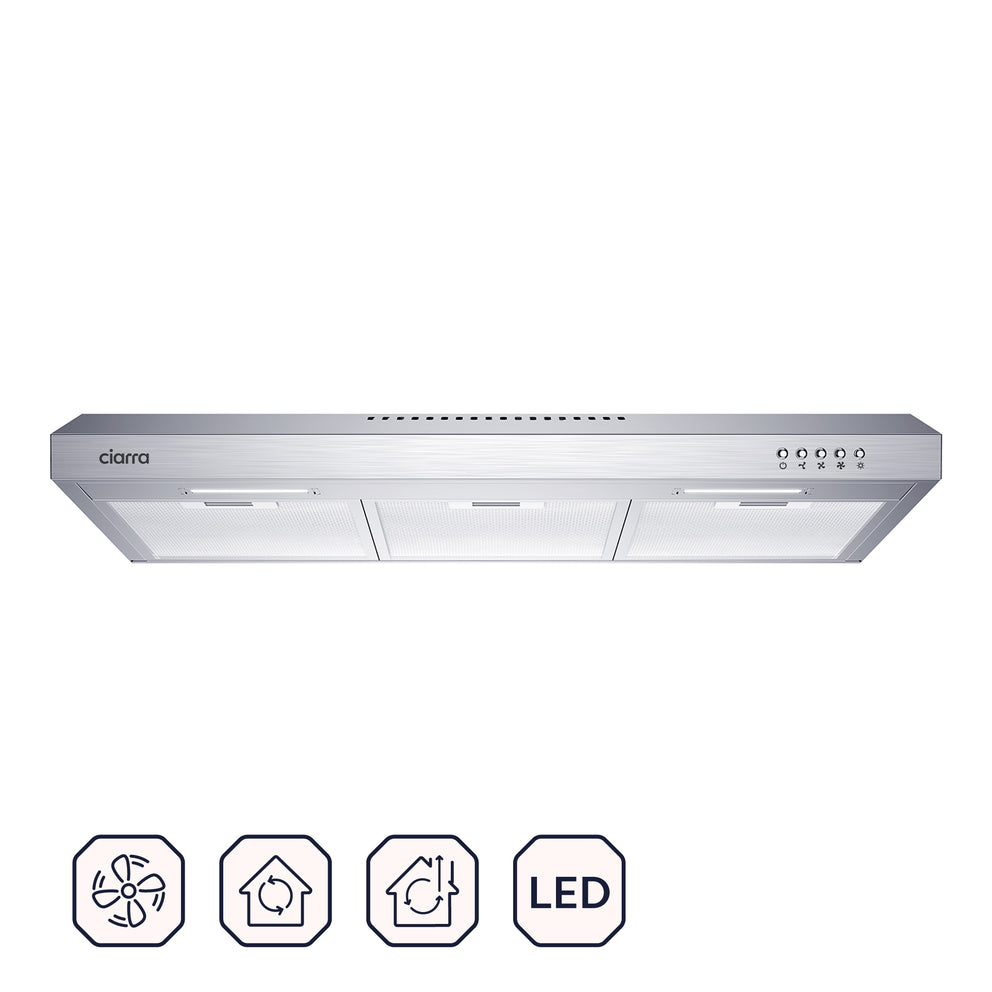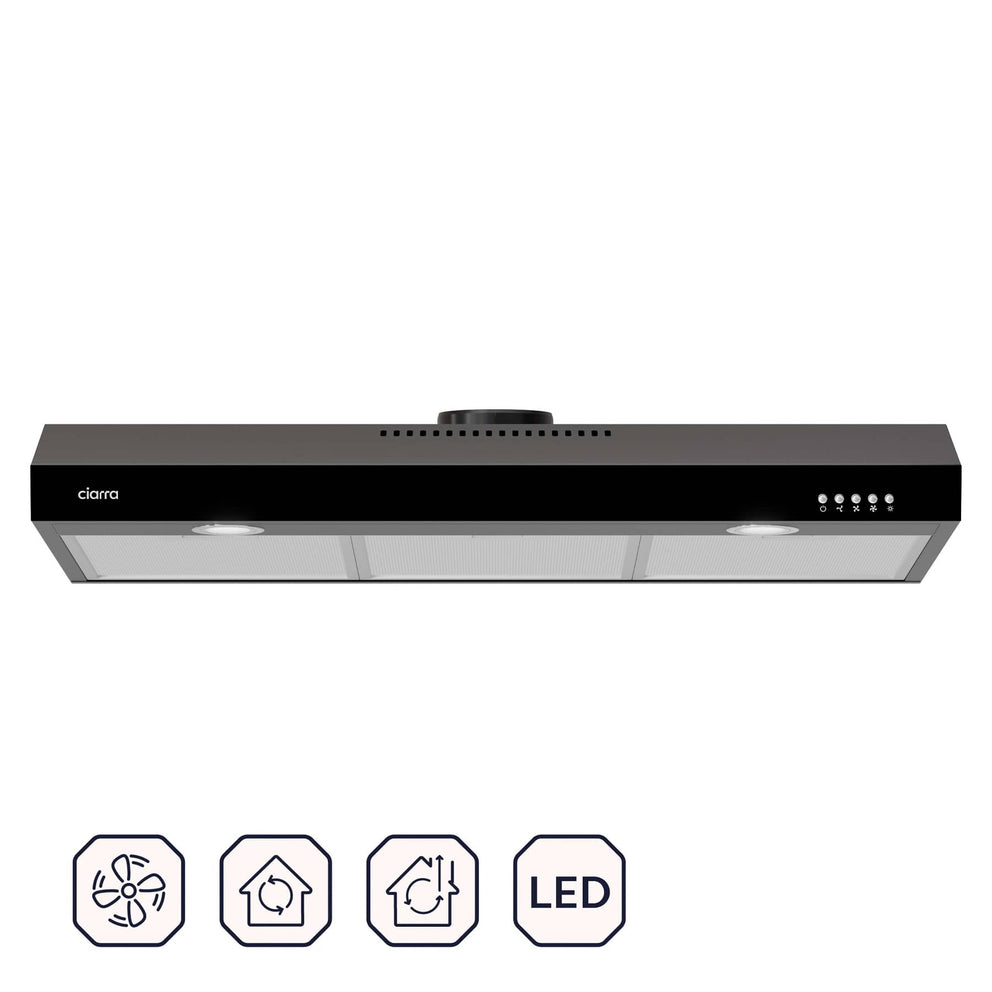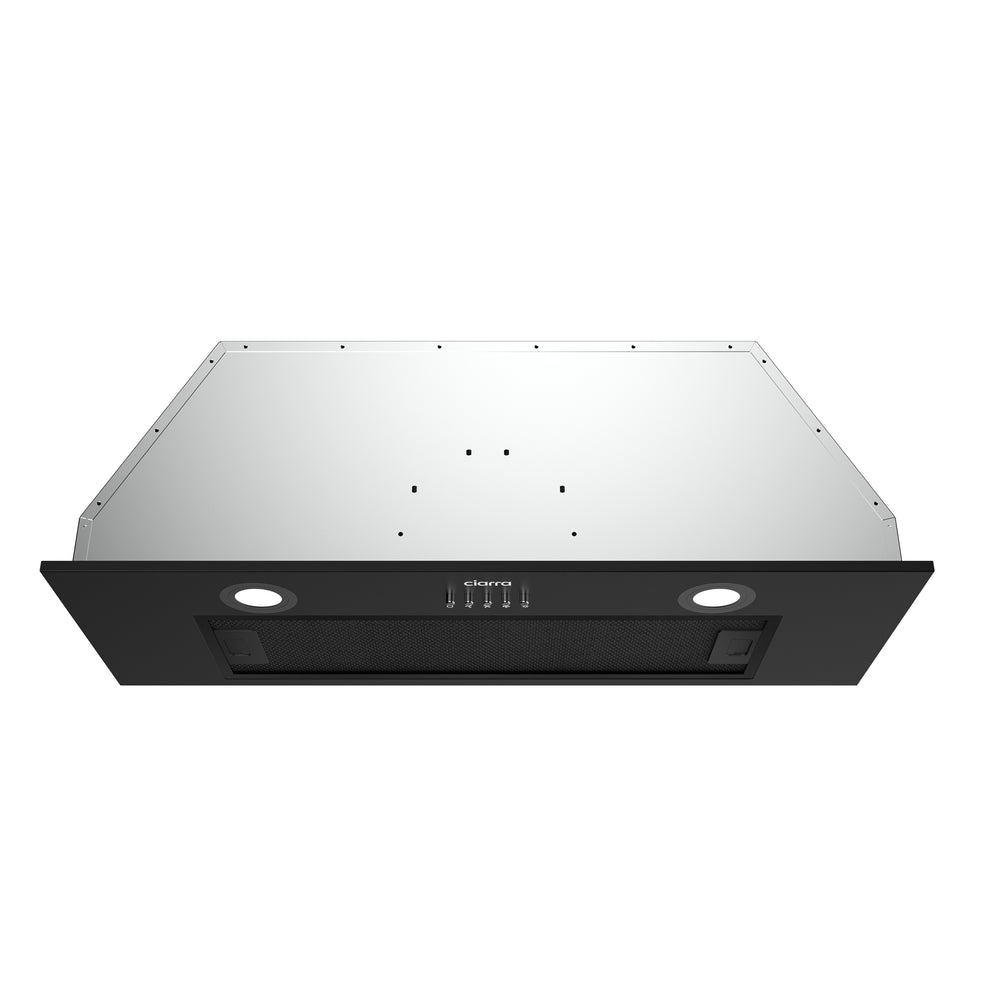Choosing the right under-cabinet range hood for your kitchen can significantly impact both the efficiency and aesthetics of your cooking space. Whether you’re upgrading your kitchen or installing a range hood for the first time, understanding key factors such as size, CFM (Cubic Feet per Minute), noise level, and additional features is essential to making an informed decision.
What is an Under-Cabinet Vented Range Hood?
An under-cabinet vented range hood is a type of kitchen ventilation system that is installed beneath your kitchen cabinets, typically above your stove or cooktop. This vented range hood draws in the smoke, steam, and cooking odors from your cooking area and expels them outside of your home through a duct system.
Unlike ductless range hoods, which recirculate air back into the kitchen after filtering it, vented range hoods provide superior air quality by directing the air outside, ensuring that your kitchen stays fresh and clean.

Do Under-cabinet Range Hoods Need to Be Vented?
Under-cabinet range hoods typically offer two options: venting to the outside or using a carbon filter to recirculate the air. The choice depends on your cooking habits and frequency. If you cook with heavy oils or frequently, venting outside is the best option to ensure effective odor and grease removal. However, if your cooking is lighter, the ductless option with a carbon filter may work, but keep in mind that you'll need to replace the filter regularly.
How to Choose the Best Under-Cabinet Vented Range Hood
Selecting the best under-cabinet vented range hood involves considering several important factors to ensure you choose a model that fits your needs perfectly. Here are the key aspects to consider:
1. Size
Ensure the range hood is at least as wide as your cooktop or stove for optimal efficiency. A hood that is too small for your cooking area will not effectively capture smoke and odors. For example, a 30-inch cooktop (2.5 feet) requires a range hood that is at least 30 inches wide for the best coverage.
2. CFM (Cubic Feet per Minute)
CFM measures the airflow of the range hood. A general rule of thumb is to have 100 CFM per linear foot of your cooktop. For example, a 30-inch cooktop requires at least 250 CFM, but if you cook with oils, high heat, or strong-smelling food, opting for a higher CFM (400-950) will improve performance. A higher CFM ensures better suction and faster odor removal, especially in larger kitchens.
3. Noise Level
A quiet range hood enhances your cooking experience. Look for a model with a noise level below 60 decibels for comfortable kitchen use. If noise is a concern, consider range hoods designed with quieter motors, like the CIARRA Professional Series, which delivers powerful suction while maintaining a quieter operation.
4. Material
Choosing a range hood made from high-quality materials is essential for durability and long-lasting performance. 304 stainless steel is the gold standard for range hoods as it is corrosion-resistant and rust-resistant, making it ideal for high-moisture environments like kitchens. Stainless steel hoods maintain their sleek appearance over time, even with frequent use, and are easier to clean and maintain compared to other materials.
5. Additional Features
WiFi & App Control: Many modern range hoods, like the CIARRA Professional Series, now come with WiFi connectivity and the ability to control the hood through a mobile app or voice assistants like Alexa or Google Home. This smart functionality adds convenience, allowing you to control the range hood remotely, adjust fan speeds, or even set a timer.
Gas Leakage Detection: For added safety, look for models equipped with gas leakage sensors. These sensors can detect any unusual gas levels and send an alert, ensuring your safety while cooking. This feature is especially useful for homes that use gas stoves or cooktops, offering peace of mind in case of any leaks.
6. Budget
While high-end models offer advanced features like WiFi control and gas leakage detection, it’s important to balance performance with your budget. A more affordable range hood may offer the basic features like reliable CFM and noise control, but as you increase your budget, you can enjoy additional features such as smart controls, better filtration systems, and quieter operation. Always weigh the value of the features you need versus the price.
What is the Best CFM for an Under-cabinet Range Hood?
The best CFM (Cubic Feet per Minute) for an under-cabinet range hood depends on several factors, including the type of cooktop you have, the size of your kitchen, and the ductwork. Here’s how you can calculate the right CFM for your home:
1. Type of Cooktop
For electric cooktops, a general rule of thumb is to have 100 CFM for every linear foot of cooktop. For example, if your cooktop is 30 inches wide (2.5 feet), a range hood with at least 250 CFM is recommended. This will provide adequate airflow to remove smoke, steam, and odors effectively.
For gas cooktops, which generate more heat, you’ll need a higher CFM. Gas burners produce heat measured in BTUs (British Thermal Units). To determine the necessary CFM, add the BTU ratings for all the burners on your stove. For example, a standard four-burner stove with a total BTU rating of 40,000 would require a range hood with a minimum of 400 CFM. Divide the total BTU by 100 to calculate the CFM needed.
2. Room Size
The size of your kitchen or the room where the range hood is located is also important. A good rule of thumb is to choose a range hood that can exchange the air in your kitchen at least 15 times per hour. This ensures the air is kept fresh and free from contaminants.
For instance, if your kitchen is 20' x 20' x 10' (4,000 cubic feet), the required CFM can be calculated by dividing the room’s volume by 4 (since you want the air exchanged every 4 minutes). In this case, you’d need a 1,000 CFM range hood or higher to maintain optimal air quality.
3. Ductwork
The length and layout of your ductwork also affect the required CFM. The longer the ductwork, the harder it is for the fan to push air through, so you’ll need a more powerful motor. For every foot of ductwork, add one additional CFM. If your ductwork has elbow bends, add 25 CFM for each bend and 40 CFM for the cap.
Introducing the CIARRA Professional Series 34-inch Under-cabinet Vented Range Hood
If you’re looking for a powerful and efficient under-cabinet range hood, the CIARRA Professional Series 34-inch Built-In Range Hood (CAS34927A-OW) is a top choice. With a max 950 CFM, this range hood is perfect for those who need strong suction power to handle heavy cooking. Whether you're preparing greasy meals or making a big batch of stir-fry, this hood will keep your kitchen air fresh.
Key features include:
- 4-Speed Levels: Adjust the ventilation according to your cooking needs, with a boost function for maximum power.
- Smart Control: Control the range hood using voice commands or the Smart Life App. Compatible with Alexa and Google Home, it adds convenience to your cooking.
- Dishwasher-Safe Baffle Filters: Simplify maintenance with filters that are easy to clean and maintain.
- Gas Leakage Detect Sensors: For added safety, this model comes equipped with sensors to detect gas leaks, ensuring peace of mind while you cook.
- Dual Ventilation Options: Choose between venting the air externally or using the Plasma+ System (sold separately) for internal air purification.
The CIARRA Professional Series Range Hood is designed for modern kitchens, with a stainless steel finish and durable motor housing. Its 950 CFM motor effectively captures grease and fumes, and the delay shut-off function ensures the system continues running to remove lingering odors after you’ve finished cooking.
With advanced features and a sleek design, this range hood makes an excellent addition to both professional kitchens and home cooking spaces.
Comparison of Range Hoods: CIARRA vs. Broan-NuTone vs. ZLINE
| Feature | CIARRA Professional Series 34-Inch Built-In Range Hood | Broan-NuTone 413004 30-Inch Under Cabinet Range Hood | ZLINE 36-Inch Under Cabinet Range Hood |
|---|---|---|---|
| Size | 34 inches | 30 inches | 36 inches |
| Max CFM | 950 CFM | 160 CFM | 760 CFM |
| Motor Power | Superior motor housing | Standard motor | High-performance motor |
| Material | 304 Stainless steel | White finish (aluminum construction) | Stainless steel |
| Filter Type | Dishwasher-safe baffle filters | Aluminum mesh filter | Stainless steel baffle filters |
| Control Type | Touch control, WiFi, Voice, Smart Life App | Mechanical push-button control | Push-button controls |
| Smart Features | WiFi, Voice control, Smart Life App | None | None |
| Noise Level | 6.5 sones | 6.5 sones | 7 sones |
| Special Features | Gas leakage detection sensors, delay shut-off, Plasma+ compatibility (sold separately) | Affordable and reliable for smaller kitchens | High suction power, ideal for large kitchens |
| Installation Type | Built-in, wall-mounted | Under-cabinet | Under-cabinet |
| Price Range | Mid to High | Budget-Friendly | Mid to High |
| Warranty | 24 months | 1 year |
1 years |
If you’re looking for a high-performance, smart, and feature-packed range hood, the CIARRA Professional Series is the best choice, especially for larger kitchens or intense cooking. The ZLINE offers excellent performance for large kitchens with its 760 CFM, while the Broan-NuTone is a budget-friendly option for smaller kitchens with more basic needs.
How to Install Under-Cabinet Range Hood Vent?
Measure and Mark:
Choose the installation height for the range hood, typically 24 to 30 inches above the cooktop.
Mark the location on the underside of the cabinet for mounting the hood.
Cut the Hole for Ductwork:
Use a jigsaw to cut a hole in the cabinet for the ductwork. Make sure the hole is the correct size for your duct, typically 6 inches in diameter.
Install Mounting Brackets:
Secure the mounting brackets to the underside of the cabinet. Ensure they are level and spaced to support the weight of the range hood.
Connect the Ductwork:
Attach the duct to the range hood's vent outlet and secure it with duct tape or a clamp.
If venting outside, connect the duct to the exterior vent cap.
Mount the Range Hood:
Lift the range hood and secure it to the mounting brackets. Double-check alignment before fully tightening the screws.
Connect the Wiring:
For electrical connections, follow the manufacturer's instructions. If necessary, hire an electrician for safe installation.
Test the Ventilation:
Turn the range hood on to test airflow and ensure the system works properly. Check for any leaks in the ductwork or connections.
Related: How to Install Professinal Range Hood
Conclusion
An under cabinet vented range hood is an essential appliance for any kitchen, offering powerful ventilation, improved air quality, and sleek design. By understanding the key features and benefits of these range hoods, you can make an informed decision and select the best model for your kitchen. Whether you're looking for a budget-friendly option or a high-end model, there are plenty of choices available to suit your needs and elevate your kitchen's functionality and style.





